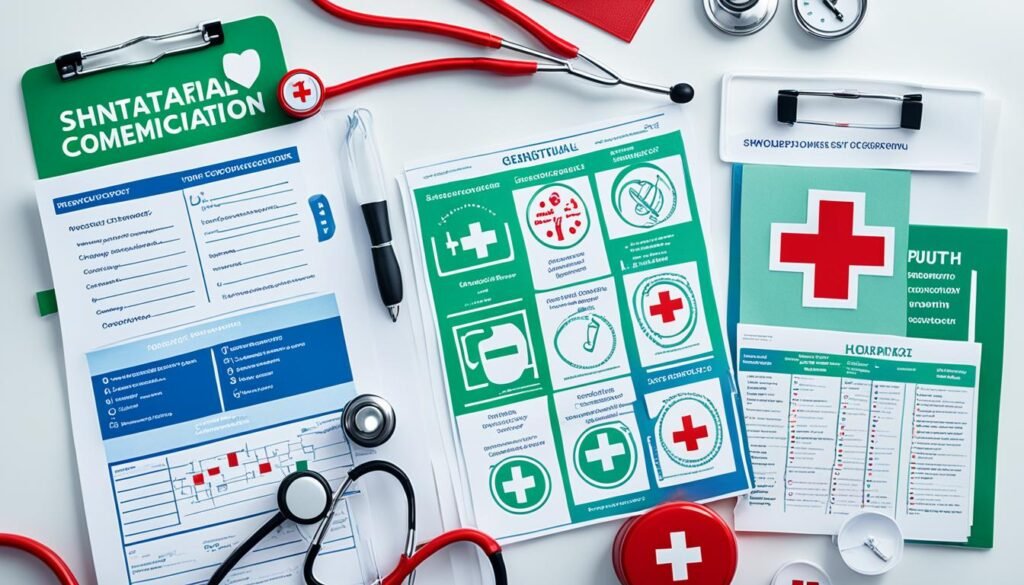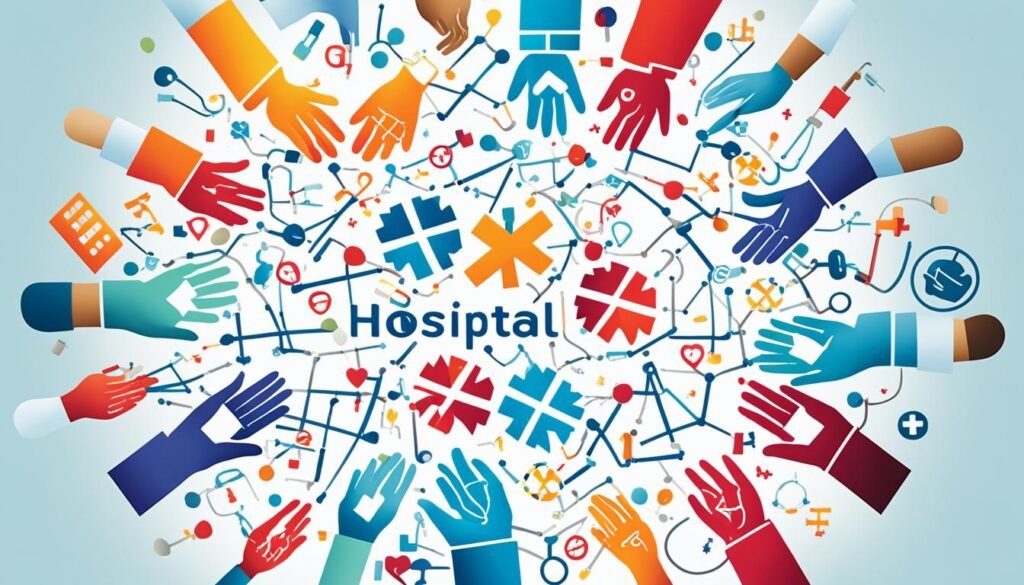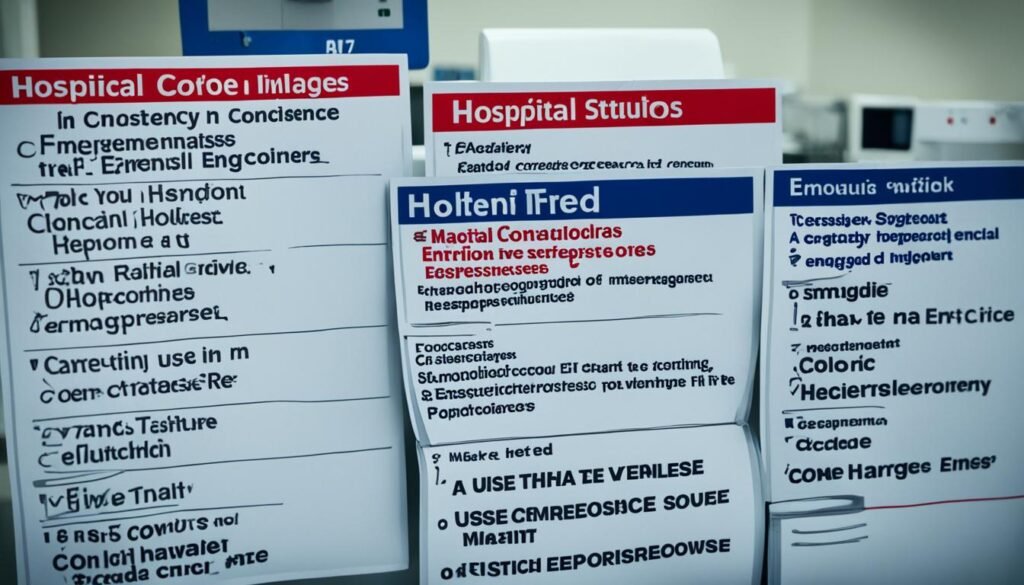Hospital emergency codes play a crucial role in ensuring the safety and well-being of patients and staff during emergencies. These coded messages serve a specific purpose in alerting hospital staff to various on-site emergencies, enabling them to respond swiftly and effectively. The primary objective of hospital codes is to communicate essential information quickly and accurately, while also preventing panic among visitors.
Emergency situations require seamless coordination among hospital staff, and the use of codes facilitates this process. From cardiac arrests to fire outbreaks, each emergency has a designated code that allows trained personnel to respond promptly and appropriately. These codes are often announced over a public address system or communicated directly to staff, ensuring a rapid and synchronized response to the situation at hand.
Patient safety is at the forefront of hospital code protocols. By adopting standardized codes, hospitals aim to improve communication and coordination not only within their facilities but also between different healthcare providers and facilities. This standardization leads to enhanced patient safety, better outcomes during emergency situations, and an overall more efficient emergency response system.
In the following sections, we will explore the importance of hospital emergency codes, common codes used in different hospitals, benefits of standardization, challenges in implementing standardized codes, and the role of hospital associations in code standardization projects. We will also discuss the transition from color code systems to plain-language alerts, the benefits of standardized communication, and examples of standardized emergency codes. Finally, we will highlight the progress being made towards a consistent emergency alert system and the key takeaways from this discussion.
Key Takeaways: Hospital Codes
- Hospital emergency codes serve to alert hospital staff and coordinate their response during on-site emergencies.
- Standardized codes improve communication and coordination between hospitals and healthcare providers, enhancing patient safety.
- Common hospital emergency codes include Code Blue, Code Gray, Code Red, and Code Black.
- Standardized communication in emergencies leads to consistent responses and improved public safety.
- The transition from color code systems to plain-language alerts increases clarity and awareness during emergencies.
The Importance of Hospital Emergency Codes
Hospital emergency codes are a critical component of ensuring the safety and security of both patients and staff during emergency situations. These codes enable trained hospital personnel to respond swiftly and appropriately to various types of emergencies, minimizing potential risks and ensuring efficient management of critical situations.
When an emergency code is activated, it serves as an alert to hospital staff, notifying them of the specific nature of the emergency and guiding them on the appropriate actions to take. These codes are often communicated through the hospital’s public address system or directly to staff members, ensuring that everyone is aware of the situation and can respond accordingly.
The implementation of standardized emergency codes is a priority for hospital associations and healthcare organizations. Standardized codes streamline the response process, allowing for better coordination and communication between healthcare facilities in times of crisis. By adopting consistent emergency code protocols, hospitals can enhance their emergency response capabilities and improve patient outcomes.
Effective emergency codes enable hospital staff to respond quickly and effectively, promoting a safe and secure healthcare environment for both patients and healthcare providers.
Hospital associations play a vital role in promoting the standardization of emergency codes. These associations collaborate with healthcare facilities to develop guidelines and best practices, ensuring the adoption of effective code systems. The efforts of hospital associations contribute to the overall improvement of emergency response and patient safety across the healthcare industry.
By emphasizing the importance of hospital emergency codes and fostering their standardization, healthcare organizations can enhance staff preparedness, improve patient outcomes, and ultimately provide a higher standard of care during emergency situations.
Benefits of Hospital Emergency Codes:
- Prompt and appropriate response to emergencies
- Enhanced communication and coordination among hospital staff
- Improved patient safety
- Efficient management of critical situations
- Streamlined emergency response protocols
Hospital emergency codes are an essential tool for preparedness and response in healthcare facilities. Adopting standardized codes and promoting their use will continue to play a significant role in ensuring the safety and well-being of both patients and hospital staff.
| Emergency Code | Description |
|---|---|
| Code Blue | Cardiac arrest or medical emergency |
| Code Red | Fire or smoke |
| Code Black | Bomb threat |
| Code Gray | Combative or aggressive individual |
| Code Green | Activation of emergency operations plan |
| Code Silver | Active shooter |
| Code Orange | Hazardous material incident |
| Code White | Evacuation |
| Code Pink | Infant or child abduction |
| Code Yellow | Missing patient |
Common Hospital Emergency Codes
Across different hospitals, various common emergency codes are used to communicate different types of emergencies. These codes are essential for swiftly relaying information and ensuring appropriate responses. Here are some of the most widely recognized hospital emergency codes:
- Code Blue: This code is typically activated in the event of a cardiac arrest or life-threatening medical emergency. It alerts hospital staff to respond immediately and provide the necessary medical intervention.
- Code Gray: When a combative or aggressive individual poses a threat, the hospital may announce a Code Gray. This code alerts staff to exercise caution and take appropriate measures to ensure the safety of all individuals.
- Code Green: Hospitals activate a Code Green when there is a need to implement emergency operations plans. This code signifies a situation that requires the activation of specialized protocols and resources.
- Code Red: In the event of a fire or the presence of smoke in the hospital, a Code Red is initiated. This code prompts immediate evacuation and the implementation of fire safety protocols.
- Code Black: A Code Black is announced in response to a bomb threat or the suspicion of a bomb in the hospital premises. It triggers evacuation procedures and coordination with law enforcement agencies.
- Code Silver: When there is an active shooter situation within the hospital or its vicinity, a Code Silver is implemented. This code alerts staff to enact lockdown procedures and collaborate with law enforcement to ensure the safety of patients and staff.
- Code Orange: Hospitals use a Code Orange to indicate a hazardous material incident or the presence of a chemical spill. This code prompts the proper mobilization of resources and the initiation of decontamination protocols.
- Code White: When an evacuation is necessary due to a natural disaster, structural damage, or other emergencies, hospitals utilize a Code White. This code denotes the need for a systematic and organized evacuation process.
- Code Pink: A Code Pink is activated if there is a confirmed or suspected infant or child abduction within the hospital. This code ensures the rapid response and implementation of security measures to locate and secure the missing child.
- Code Yellow: When a patient is reported missing or unaccounted for, hospitals initiate a Code Yellow. This code prompts a thorough search and the mobilization of staff to locate the missing individual promptly.
These emergency codes facilitate clear and effective communication during critical situations, allowing hospital staff to respond appropriately and ensure the safety and well-being of patients, staff, and visitors.
Benefits of Hospital Emergency Codes

Hospital emergency codes play a crucial role in ensuring the safety and well-being of patients and staff during emergencies. These codes provide numerous benefits that contribute to effective emergency response, patient safety, and staff coordination.
One of the key benefits of hospital emergency codes is the establishment of a coordinated response system. These codes enable hospitals to swiftly and efficiently respond to emergencies, ensuring that appropriate actions are taken promptly. By having standardized codes in place, hospitals can communicate effectively with their staff, healthcare providers, and other facilities, facilitating seamless coordination and collaboration.
Standardized codes also improve communication and understanding during emergency situations. With a common set of codes, all healthcare professionals involved in the response are familiar with the terminology and actions required. This consistent communication reduces confusion and allows for quick decision-making, ultimately enhancing patient safety and outcomes.
Furthermore, hospital emergency codes greatly enhance staff coordination. During emergencies, clear and concise communication is essential to ensure that all personnel are on the same page and can work together efficiently. By utilizing standardized codes, hospitals can streamline their communication processes, minimizing errors and improving overall response effectiveness.
“Standardized codes improve communication and coordination between different facilities and healthcare providers, ultimately leading to enhanced patient safety and better outcomes during emergency situations.”
Utilizing standardized codes also facilitates effective communication with emergency responders outside of the hospital, such as paramedics, firefighters, and law enforcement officers. By using familiar codes, hospitals can convey essential information rapidly and accurately, ensuring that external responders can act quickly and appropriately.
In conclusion, hospital emergency codes are critical for patient safety, staff coordination, and efficient emergency response. By implementing standardized codes, hospitals can improve their communication and coordination efforts during emergencies, ultimately leading to better outcomes and increased public safety.
Lack of Code Standardization and the Need for Improvement

One of the major challenges in hospital emergency code systems is the lack of standardization. Currently, there is no national standard for these codes in the United States, resulting in confusion and inconsistencies among different hospitals and healthcare facilities. Without a uniform system in place, it becomes difficult for healthcare providers to effectively communicate and coordinate during emergencies, potentially compromising patient safety and overall response efficiency.
To address this issue, many states and hospital associations have undertaken code standardization projects. These initiatives aim to establish a national standard for hospital emergency codes, ensuring a consistent and effective system of emergency notifications across healthcare facilities. By implementing a national standard, hospitals can enhance their emergency response capabilities and improve public safety.
“The lack of standardization in hospital emergency codes creates unnecessary confusion and can hinder the ability of healthcare providers to respond efficiently during emergencies. Establishing a national standard is crucial to ensure seamless communication and coordination.” – Dr. Amanda Johnson, Emergency Medicine Specialist
Code standardization projects involve collaboration between healthcare professionals, hospital associations, and regulatory bodies. These efforts focus on developing comprehensive guidelines that encompass various emergency situations and provide standardized protocols for communication and response. By adhering to these guidelines, hospitals can mitigate confusion, prevent delays in emergency response, and ultimately save lives.
Furthermore, code standardization projects aim to promote a more cohesive and effective emergency management system on a national level. By implementing a standardized code system, hospitals can facilitate interoperability between different healthcare facilities and enhance coordination during multi-agency responses. This not only streamlines the communication process but also improves resource allocation and overall emergency preparedness.
The Need for a National Standard
The lack of standardization in hospital emergency codes can lead to various negative consequences, including:
- Confusion and miscommunication among healthcare providers
- Delayed responses due to unfamiliarity with codes
- Inconsistent emergency protocols
- Potential errors in emergency documentation
- Difficulty in cross-organizational coordination during large-scale emergencies
These challenges highlight the urgent need for a national standard for hospital emergency codes. By implementing a standardized system, healthcare facilities can overcome these obstacles and ensure a more efficient and effective response to emergencies, ultimately protecting the well-being of patients and staff.
| Challenges | Solutions |
|---|---|
| Lack of standardization | Implement a national standard for hospital emergency codes |
| Confusion and miscommunication | Create comprehensive guidelines and protocols |
| Inconsistent emergency response | Ensure adherence to standardized codes and protocols |
| Difficulty in cross-organizational coordination | Promote interoperability between healthcare facilities |
The Use of Plain Language Alerts

As part of the standardization efforts, many hospitals are transitioning from color code systems to plain-language alerts. This shift involves using clear and concise language to communicate emergency situations, such as announcing “fire” instead of “Code Red.” Plain language alerts aim to decrease confusion among staff, particularly those who work at multiple facilities, and also increase public awareness and response during emergencies.
By replacing complex codes with plain language alerts, hospitals facilitate better understanding and immediate action. Staff members can quickly grasp the nature of the emergency, enabling them to respond appropriately and efficiently. Furthermore, plain language alerts have the potential to increase public safety by providing clear instructions and information during crisis situations.
Several states and healthcare organizations recognize the benefits of plain language alerts and recommend their use for hospital emergencies. By embracing plain language alerts, hospitals can enhance hospital communication, ensure efficient emergency response, and contribute to increased public safety.
Implementing plain language alerts requires clear internal communication and training programs that emphasize the importance of using easily understandable language. It also necessitates updating emergency protocols and ensuring consistency across all facilities within a healthcare system. These efforts contribute to the ongoing standardization initiatives and support the overall goal of improving communication and response during hospital emergencies.
The Benefits of Standardized Communication

When it comes to hospital emergencies, standardized communication plays a crucial role in ensuring the safety and well-being of patients and staff. With consistent and clear communication protocols in place, healthcare providers across different hospitals can respond effectively and efficiently to emergencies, leading to improved patient outcomes and increased public safety.
One of the key advantages of standardized communication is the seamless coordination and collaboration it enables during emergency situations. When everyone follows the same set of protocols and procedures, it becomes easier to share information, delegate tasks, and make critical decisions. This unified approach ensures that all hospitals and healthcare facilities are on the same page, working together towards a common goal of mitigating the impact of emergencies.
By adopting a uniform system of emergency notifications, hospitals can enhance their overall preparedness and response. Consistent responses enable healthcare providers to anticipate and address emergencies more effectively, minimizing the potential for errors or delays. This ultimately leads to better patient outcomes and improved public safety.
The Advantages of Standardized Communication:
- Efficient coordination: Standardized communication allows for efficient coordination and collaboration between healthcare providers during emergency situations.
- Improved response: Consistent responses ensure that healthcare providers can effectively address emergencies, leading to better patient outcomes.
- Enhanced public safety: By adopting a uniform system of emergency notifications, hospitals can improve public safety and instill confidence in the community.
To illustrate the importance of standardized communication, consider the following example:
“During a Code Blue situation, every second counts. With standardized communication in place, healthcare providers immediately recognize the urgency and respond promptly. This level of consistency and preparedness can make a significant difference in saving lives.” – Dr. Sarah Turner, Emergency Department Director at St. Mary’s Hospital.
Achieving standardized communication requires collaboration and a commitment to best practices. Hospitals and healthcare facilities can work together with national organizations and governing bodies to establish guidelines and protocols. Through regular trainings and drills, healthcare providers can familiarize themselves with the standardized communication system, enabling them to respond effectively to emergencies.
Standardized communication is a powerful tool in ensuring prompt and coordinated responses to hospital emergencies. By adopting consistent protocols and systems, hospitals can enhance the safety and well-being of their patients and staff, ultimately advancing the goal of public safety.
Examples of Standardized Emergency Codes

Standardized emergency codes have been implemented in various regions and states to ensure effective communication and coordination during emergencies. These codes are designed to provide clear instructions to hospital staff and enhance response protocols. Let’s take a look at some examples:
1. Code Blue: Medical Emergency
In the event of a medical emergency, such as a cardiac arrest or life-threatening condition, hospitals commonly use “Code Blue” to alert staff and initiate emergency response protocols. This code ensures that the necessary medical personnel are immediately dispatched to the location and provide critical care to the patient.
2. Code Red: Fire
When there is a fire or the presence of smoke in a healthcare facility, “Code Red” is activated to notify staff and initiate immediate evacuation procedures. This code ensures the safety of patients, staff, and visitors by effectively communicating the presence of a fire emergency.
3. Code Black: Bomb Threat
“Code Black” is used to indicate the presence of a bomb threat within a hospital or healthcare facility. When activated, this code prompts staff to follow specific protocols to ensure the safety of everyone on the premises and coordinate with relevant authorities to address the threat.
“Standardized emergency codes provide clear instructions to hospital staff and enhance response protocols during various emergencies.”
These are just a few examples of standardized emergency codes that hospitals may utilize. While codes may vary between regions and healthcare facilities, the goal is to establish a common language and understanding among hospital staff, aiding in effective communication and coordinated emergency response.
Challenges in Implementing Code Standardization
Implementing code standardization in hospital emergency systems presents several challenges that need to be overcome to ensure effective coordination and response. One major obstacle is the lack of a national standard for hospital emergency codes, resulting in inconsistencies between different hospitals and regions.
These inconsistencies pose difficulties in the training and transition process for healthcare personnel when moving between different healthcare facilities. A lack of uniformity in code systems can lead to confusion and delays in emergency response.
However, despite these challenges, many healthcare systems are dedicated to improving standardization efforts. They are actively working towards creating a more unified and standardized system of emergency communication.
By establishing a national standard for hospital emergency codes and facilitating training programs, healthcare organizations can enhance coordination and response during emergency situations.
Training Challenges
One significant challenge in implementing code standardization is ensuring comprehensive training for all hospital staff members. Different hospitals may have varying training protocols, leading to inconsistencies in knowledge and understanding of emergency codes.
To address this challenge, healthcare systems need to prioritize standardized training programs that cover the correct implementation, interpretation, and response to different codes. This will ensure that all staff members are well-prepared to handle emergencies and can effectively communicate with each other during critical situations.
Transition Process Challenges
The transition process from existing code systems to standardized ones can pose challenges due to the need for retraining and reprogramming of various systems and equipment. This includes updating public address systems, emergency response protocols, and communication devices.
During the transition period, it is essential to ensure clear communication channels and provide appropriate training to staff members to minimize confusion and ensure a smooth adoption of the standardized code system.
Additionally, the transition process requires consistent monitoring and evaluation to address any issues that may arise and implement effective solutions promptly.
Overcoming the Challenges
To overcome these challenges, a collaborative approach is necessary among healthcare organizations, hospital associations, and regulatory bodies to establish a national standard for hospital emergency codes.
Training programs should be developed and implemented to ensure consistent and comprehensive education for all healthcare personnel. This would include ongoing training updates to address any changes or additions to the standardized code system.
Furthermore, a phased approach to the transition process can help alleviate challenges by gradually implementing standardized codes and providing adequate support and resources to healthcare facilities during the transition period.
The Role of Hospital Associations and Organizations

Hospital associations and organizations play a critical role in promoting code standardization and coordination efforts within the healthcare industry. These associations provide valuable guidance, resources, and support to hospitals and healthcare facilities to help them adopt standardized emergency codes.
By collaborating on national guidelines and best practices, hospital associations facilitate the development and implementation of effective emergency communication systems. They bring together experts from various healthcare institutions to share their knowledge and experiences, ensuring that the codes implemented are comprehensive and aligned with industry standards.
The efforts of hospital associations and organizations contribute to enhancing patient safety and improving overall emergency response in healthcare settings. Through their standardization projects, they drive consistency and accuracy in emergency communication, enabling healthcare providers to respond swiftly and effectively during critical situations.
Hospital associations also play a vital role in coordinating the dissemination of information and guidelines related to emergency codes. They ensure that hospitals stay informed about the latest developments in code standardization and provide ongoing support to healthcare facilities in implementing these standardized codes.
Quote:
“Hospital associations and organizations are at the forefront of standardization projects. Their commitment to national guidelines and best practices helps us improve emergency response coordination, ultimately enhancing patient safety.” – Dr. Emily Johnson, Emergency Services Director
By promoting code standardization and coordination efforts, these associations contribute to the overall preparedness and resilience of the healthcare system. They help establish a unified approach to emergency communication, ensuring that hospitals across the country can effectively communicate with each other during times of crisis.
Overall, the role of hospital associations and organizations in code standardization is invaluable. Through their collaborative efforts and dedication, they support hospitals in providing the best possible care to patients, enhancing public safety, and improving emergency response across the healthcare industry.
Moving Towards a Consistent Emergency Alert System

Progress is being made towards a more consistent emergency alert system in hospitals. Many states and large hospital associations now recommend standardized codes or the adoption of plain language alerts. This trend reflects the growing awareness of the importance of clear and effective communication during emergencies. By adhering to these recommendations, hospitals can improve their emergency response capabilities and ensure the safety and well-being of their patients and staff.
The standardization progress in emergency alert systems is an essential step towards enhancing public safety in hospitals. State recommendations and the adoption of plain language alerts have gained significant momentum due to increased awareness of the critical role communication plays in emergency situations. By implementing standardized codes or transitioning to plain language alerts, hospitals can streamline their emergency response processes and facilitate effective communication.
The adoption of standardized codes or plain language alerts brings several benefits to hospitals and healthcare facilities. Firstly, it enables staff to quickly understand and respond to emergency situations, reducing confusion and improving overall response times. Standardized codes also enhance coordination among healthcare providers and support seamless collaboration during emergencies.
State recommendations and the adoption of plain language alerts have increased awareness regarding the need for clear and effective communication in emergencies. By adhering to these guidelines, hospitals can significantly improve their emergency response capabilities and, ultimately, the safety of their patients and staff.
Plain language adoption fosters increased awareness and understanding among hospital staff, leading to enhanced response efficiency and patient safety. By using language that is easily understandable to healthcare professionals and the general public, hospitals can ensure prompt and appropriate actions are taken during emergencies.
Benefits of Standardizing Emergency Alert Systems:
- Improved communication: Standardized codes and plain language alerts enable clear and concise communication during emergencies, reducing the potential for misinterpretation and confusion.
- Enhanced coordination: Standardized alert systems facilitate seamless coordination and collaboration between hospitals, emergency services, and healthcare providers, ensuring a unified response to emergencies.
- Increased public safety: Clear and effective communication through standardized codes and plain language alerts raises public awareness and enables individuals to respond appropriately during emergency situations.
State Recommendations and Plain Language Adoption:
Many states have recognized the need for standardization and have recommended the adoption of plain language alerts for emergency communication. These recommendations aim to ensure consistent and easily understandable alerts across healthcare facilities, improving response times and patient outcomes.
The table below highlights the status of standardization progress and plain language adoption in different states:
| State | Standardization Progress | Plain Language Adoption |
|---|---|---|
| New York | In progress | Recommended |
| California | Completed | Implemented |
| Texas | On track | Pilot programs |
The table above illustrates the varying degrees of progress and adoption across states. While some states have achieved full standardization and implemented plain language alerts, others are still in the early stages or conducting pilot programs to assess the effectiveness of these communication methods.
The continuous efforts towards standardization and plain language adoption demonstrate the commitment of hospitals, state governments, and healthcare associations to improving emergency response systems. By aligning with state recommendations and adopting plain language alerts, hospitals can contribute to a more consistent and effective emergency alert system, ultimately ensuring increased public safety and better patient outcomes.
Code Blue
“Code Blue” is a hospital emergency code used to indicate a patient requiring immediate resuscitation, often due to cardiac or respiratory arrest. When announced over the hospital’s intercom system, medical staff rush to the patient’s location with crash carts equipped with life-saving equipment like defibrillators and medications. The goal is to quickly assess and stabilize the patient’s condition to prevent permanent harm or death. Team coordination and rapid response are critical in these situations to maximize the chances of successful resuscitation and recovery.
Code Gray
“Code Gray” typically denotes a security-related emergency in a healthcare setting, such as the presence of a combative or violent individual, a threat of harm, or an actual act of violence. When announced, hospital staff enact specific security protocols to ensure the safety of patients, visitors, and staff members. This may involve securing the affected area, contacting law enforcement, and implementing measures to de-escalate the situation. Staff members are trained to respond swiftly and effectively to mitigate risks and protect everyone involved until the situation is resolved and normal operations can resume.
Code Green
“Code Green” often signifies a mass casualty incident involving multiple patients, such as a natural disaster, large-scale accident, or terrorist attack. Upon activation, medical teams mobilize to triage, treat, and transport patients according to the severity of their injuries. Hospitals prepare to receive and care for a surge of patients, coordinating resources, personnel, and facilities to ensure the best possible outcomes. Effective communication, organization, and collaboration among healthcare providers are crucial during these emergencies to prioritize care and allocate resources where they are most needed. The goal is to provide swift and effective medical assistance to all affected individuals.
Also Read: Your Guide To Medical Sales Jobs Career Paths
Conclusion
Hospital codes are a critical component of emergency response and patient safety in healthcare facilities. These codes enable swift and effective responses to various on-site emergencies, ensuring the well-being of both patients and staff. While standardization efforts are still ongoing, progress is being made to improve communication and coordination during emergencies.
By adopting standardized codes or transitioning to plain language alerts, hospitals can enhance their emergency response capabilities. Standardization efforts aim to create a more consistent and effective system of emergency notifications, allowing for seamless coordination and collaboration between different facilities and healthcare providers.
Ultimately, the implementation of standardized hospital codes or plain language alerts will lead to better patient outcomes and increased public safety. Hospitals across the country are working towards this goal, demonstrating their commitment to enhancing emergency response and continuing to prioritize patient safety.
FAQs
Q: What are hospital codes and what is their purpose?
A: Hospital codes are specific emergency signals used in healthcare facilities to alert staff about different emergencies and standardize responses. The purpose of hospital codes is to ensure a quick and organized response to various emergencies to enhance the safety and security of patients, visitors, and staff.
Q: What is the significance of color codes in hospital settings?
A: Color codes in hospitals, such as code blue, code red, and code yellow, represent specific emergencies or situations that require immediate attention and response. Each color code corresponds to a different type of emergency to guide staff on how to act swiftly and effectively.
Q: How many different codes are typically used in hospitals?
A: Hospitals can use a wide range of codes, with some facilities implementing up to 47 different codes. These codes cover various emergencies such as pediatric emergencies, respiratory issues, security threats, and mass casualty incidents.
Q: What is the role of security personnel during a hospital code activation?
A: Security personnel play a crucial role during hospital code activations by assisting in maintaining order, restricting access to certain areas, ensuring the safety of individuals, and coordinating communication among staff members and emergency responders.
Q: How do hospital codes help in emergency management?
A: Hospital codes help in emergency management by providing a standardized method of communication and response coordination during crises. By using specific codes, hospitals can ensure a prompt and efficient reaction to emergencies, ultimately enhancing the overall safety and security of the facility.
Q: What actions are taken when a code purple is activated in a hospital?
A: A code purple in a hospital typically indicates an infant abduction. When this code is activated, security measures are implemented to prevent the unauthorized removal of an infant from the facility, ensuring a swift response to protect the infant and reunite them with their family.
Q: How are hospital codes standardized across different healthcare facilities?
A: Hospital codes are often standardized through the implementation of specific policies and procedures that align with regulatory requirements, such as those set by The Joint Commission or state healthcare authorities. This standardization ensures consistency in code usage and response strategies across different hospitals.
